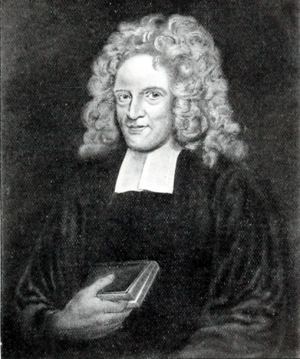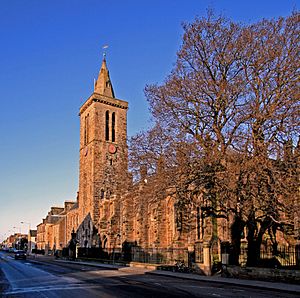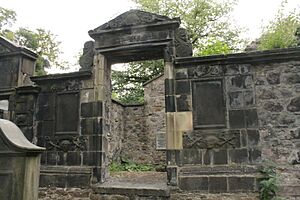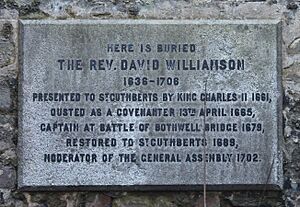David Williamson (minister) facts for kids
Quick facts for kids David Williamson |
|
|---|---|

Portrait of Williamson by John Baptist Medina
|
|
| Personal details | |
| Born | 1634 St Andrews, Scotland |
| Died | 6 August 1706 (aged 71–72) |
| Nationality | Scottish |
| Denomination | Presbyterian |
David Williamson (born around 1634 – died 6 August 1706) was an important Scottish minister. He was a Covenanter, a group who supported the Presbyterian Church in Scotland. In 1702, he became the leader of the General Assembly of the Church of Scotland.
Williamson is well-known for his long connection to Edinburgh's West Kirk. He is also famous for a traditional Scottish song called "Dainty Davie". His support for the Covenanters caused him many problems. He was even declared a rebel and had to hide from the law. He escaped capture many times. One of his most famous escapes is told in the "Dainty Davie" song. Williamson also fought as a commander in the Battle of Bothwell Bridge. After a time of hiding, he returned to the West Kirk. He remained there as minister until he died in 1706.
Contents
David Williamson's Life Story
His Early Years
David Williamson was born in St Andrews, Scotland. His father, William Williamson, was a glover. David was baptized on September 2, 1636. He studied at the University of St Andrews and earned his Master of Arts degree in 1655.
He was allowed to preach in 1658. In 1661, he became a minister at the West Kirk of Edinburgh. However, Williamson disagreed with King Charles II's decision. The king wanted to bring bishops back into the Church of Scotland. Williamson spoke out against this change. Because of his strong views, he was removed from his job in 1665. As he left, Williamson famously said he would return. He prophesied he would die as the minister of that church.
Living as an Outlaw
For several years, there isn't much information about Williamson. Then, in 1674, he was declared a rebel. This was because he held secret church meetings called conventicles. In the years that followed, Williamson had many close escapes from being caught. One of these escapes is remembered in the song "Dainty Davie".
In 1679, Williamson led a part of the Covenanter army. This was during the Battle of Bothwell Bridge. After Williamson's death, his son, John, shared stories of his father's adventures. Williamson was often a lonely wanderer. He sometimes had to hide behind a stone wall in the snow to rest.
In 1687, a new law allowed some Presbyterian ministers to preach again. Williamson returned to Edinburgh. He began leading a large church in the Dean Village. In 1688, he was arrested twice. Once, his name was found on a paper belonging to another Covenanter. Another time, he was accused of not praying for the new Prince of Wales. But he was released both times.
Return to the West Kirk
After the Glorious Revolution, Williamson was officially returned to the West Kirk. He kept his promise and served as minister there until he died. He was one of the church leaders sent to congratulate King William II on becoming king.
In 1702, Williamson was chosen to be the moderator. This meant he was the main leader of the Church of Scotland's General Assembly. Later in his life, Williamson invested money in the Darien scheme. This was a Scottish plan to set up a colony in Panama. He died peacefully on August 6, 1706, at about 72 years old. He left his house to the ministers who would come after him.
David Williamson's Family Life
David Williamson is well-known for having been married seven times. Here are his wives and some of his children:
- Isobel Lindsay: She died in 1665. They had one son, William, who died young.
- Margaret Scott: They had a daughter named Margaret. Margaret later married James Haswell.
- Jean Kerr: She was the daughter of William Kerr of Cherrytrees. They married around 1676. They had a daughter, Elizabeth. The story of how Jean and Williamson met is part of the "Dainty Davie" song.
- Margaret Melville: She died in 1692. They likely had a son, John, and a daughter, Agnes.
- Margaret Dougal: She was the daughter of William Dougal. They had a son, David, and a daughter, Mary.
- An unknown wife.
- Jean Straiton: She was the daughter of Arthur Straiton. They married in 1700. They had a son, Joseph, and a daughter, Jean. After Williamson died, Jean married again in 1717.
Williamson was buried in an enclosed area at the West Kirk. This was near the grave of a previous minister, Robert Pont. His family did not put a memorial inside the vault at first. Later, around the early 1900s, a memorial plaque was added by a family member.
"Dainty Davie" Song
A famous event from Williamson's time as an outlaw is remembered in the traditional Scottish song "Dainty Davie". This event was written about by Captain Creighton. Creighton was sent to find Williamson at the home of Lady Cherrytrees near Edinburgh. Lady Cherrytrees knew the soldiers were coming. She quickly dressed Williamson in women's clothes. Then she hid him in bed with her daughter, Jean. Jean pretended to be sick when the soldiers arrived. Jean later became Williamson's third wife.
The connection between Williamson and the song was known even when he was alive. Robert Wodrow told a story about Williamson going to preach in Aberdeen. A man followed him, dancing and singing "Dainty Davie." Williamson was sad that the man was disrespecting the Sabbath (Sunday). He told a friend that the man was missing his last chance to accept Christ. The man died suddenly that night.
Williamson was also known for being "dainty" in his looks and habits. When he visited the court of King William and Queen Mary, the Queen's ladies-in-waiting were interested in his appearance. It is also said that Williamson was the first minister in Scotland to own a watch. He also had a reputation for enjoying good food. A receipt from 1690 shows that the West Kirk church leaders bought a plate of mince pies for Christmas.
See also
- List of moderators of the General Assembly of the Church of Scotland





